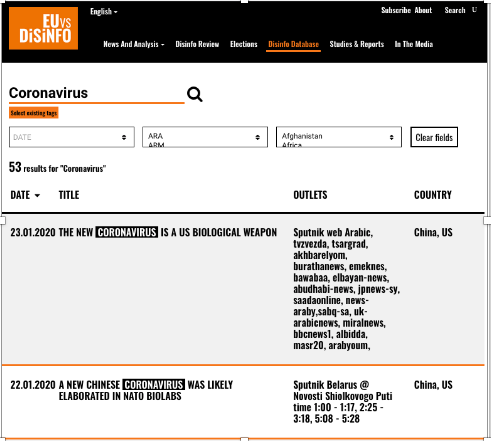It wasn’t long after the first reports of Coronavirus in late December 2019, that I wondered how it would be weaponized in Russian state-sponsored disinformation campaigns. Maybe I was hearing echoes from Operation Infektion, a 1980s’ Russian disinformation campaign that promoted the idea that HIV/AIDS was a biological weapon manufactured by the US. To test my intuition, I turned to the Disinfo Database from EUvsDisinfo, a Russian disinformation monitoring and reporting service provided by the European External Action Service’s East StratCom Task Force. While the activity volume was lower and more muted than I had anticipated, the findings were still revealing. Before we dive into the data, here’s some background.
About Disinformation: With the Russian interference campaign in the 2016 US presidential elections, disinformation became front page news. It is now recognized as one of our biggest security threats to Western governments and open societies. But the disinformation threat is not new, is not limited to the US, and is not limited to attacks against elections. For background, see CSIS for historical context, Bruce Schneier for a summary, and EU vs Disinfo for research reports and a searchable database on Russian election meddling in the US and Europe.
Disinformation targets the cracks in society in order to undermine Russia’s adversaries’ reputations, alliances, and institutions, and ultimately to weaken public trust in their governments. Russia’s disinformation playbook reveals a persistent, long-game strategy that weakens its adversaries while promoting Russia’s own foreign policy interests throughout the world. Disinformation is used in blended operations with social media amplification and cyber-attacks, and in active measures campaigns which combine disinformation with physical violence as seen in the Ukraine and Montenegro.
EU vs Disinfo: EUvsDisinfo was launched in 2015 to monitor and resist the threat from Russian disinformation campaigns to the EU and its allies. Its services include research, outreach and media monitoring (TV, news, Web, social media) in 15 languages and a database of over 7,700 samples from Russian disinformation campaigns as of 26-Feb-2020.
EU vs Disinfo Data Review: For our research we did a simple database search on the term ‘Coronavirus’. As shown in the figure below we got 53 results that matched the term (as of 26-Feb-2020). Note the outlets column represents the media (TV, Web, Social) that are effectively syndicating original content published by Russian-controlled media, such as RT and Sputnik.

Drilling down on the results set is where it gets interesting. In the table below we’ve highlighted some statistics and insights.

Here are a few observations from language targeting:
- Of the 41 Russian-language source posts, 20% could be considered warnings to neighboring countries that Russia considers insufficiently deferential to its regional hegemony – Georgia, Belarus, Azerbaijan, Ukraine.
- Russia reached its Arabic targets through close to 50 outlets reaching nearly all countries in the Middle East with a common theme – the Coronavirus is a US biological weapon used in campaigns that target racial or ethnic groups.
- Spanish language targeting is consistent with previous narratives aimed at exploiting Catalonian independence efforts. Messaging themes attacked international governments and institutions like the US, the EU and the WHO (World Health Organization), while promoting Brexit.
- For the two English targets, one post suggesting that the virus was a biological weapon was syndicated by 8 Websites. The other post, which blamed mainstream media, was focused on southfront.org, a Website considered to be a disinformation source by EUvsDisinfo, NewsGuard and other media reputation services.
Outlook: The Coronavirus story has only been running for two months in the global media and six weeks in EUvsDisinfo. We expect this story will be with us for a long time. It will be interesting to see how this initial snapshot analysis holds up. Based on what we know about the Russian disinformation playbook, we anticipate that the basic themes – US or Western bio-weapon supporting racial and ethnic aggression – will not change much. But what will change, is the targeting by country and language, and the composition of the media outlets used to syndicate and amplify the Russian-directed content. With the upcoming US elections, we expect that it will be weaponized to influence US politics. Finally, we’ll also look to see how the major social media platforms respond to Coronavirus disinformation in political advertising and user commentary on their platforms.
